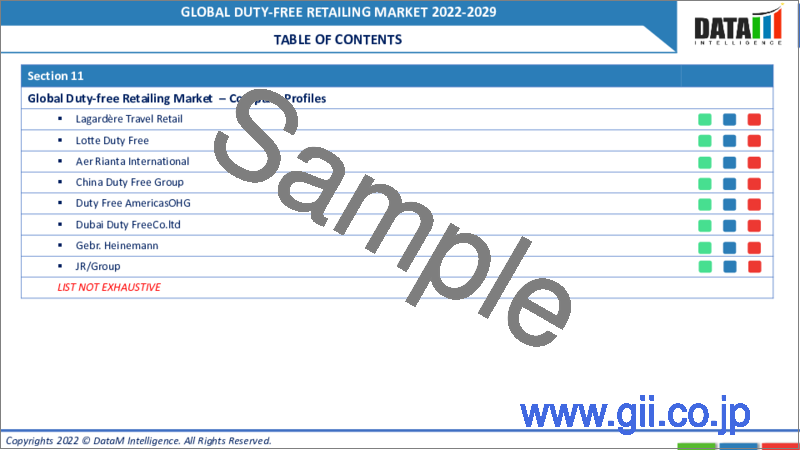|
|
市場調査レポート
商品コード
1117931
免税店の世界市場(2022年~2029年)Global Duty-free Retailing Market - 2022-2029 |
||||||
|
● お客様のご希望に応じて、既存データの加工や未掲載情報(例:国別セグメント)の追加などの対応が可能です。 詳細はお問い合わせください。 |
|||||||
| 免税店の世界市場(2022年~2029年) |
|
出版日: 2022年08月22日
発行: DataM Intelligence
ページ情報: 英文 210 Pages
納期: 約2営業日
|
- 全表示
- 概要
- 目次
世界の免税店市場は、格安航空企業の増加によって成長が促進されています。
当レポートでは、世界の免税店市場について調査分析し、市場力学、セグメント分析、地域分析、競合情勢などを提供しています。
目次
第1章 世界の免税店市場の調査手法と範囲
第2章 世界の免税店市場 - 市場の定義と概要
第3章 世界の免税店市場 - エグゼクティブサマリー
第4章 世界の免税店市場 - 市場力学
- 市場に影響を与える要因
- 促進要因
- 抑制要因
- 機会
- 影響分析
第5章 世界の免税店市場 - 業界分析
- ポーターのファイブフォース分析
- サプライチェーン分析
- 価格分析
- 規制分析
第6章 世界の免税店市場 - COVID-19分析
- 市場におけるCOVID-19の分析
- COVID-19前の市場シナリオ
- 現在のCOVID-19市場シナリオ
- COVID-19後または将来のシナリオ
- COVID-19中の価格変動
- 需給スペクトル
- パンデミック中の市場に関連する政府のイニシアチブ
- メーカーの戦略的イニシアチブ
- 結論
第7章 世界の免税店市場 - タイプ別
- ファッションアパレルとアクセサリー、高級ハードグッズ、電子機器(FHE)
- 天然繊維複合材料
第8章 世界の免税店市場 - 販売チャネル別
- 空港
- 航空機内
- 海港
- 鉄道駅
- その他
第9章 世界の免税店市場 - 地域別
- 北米
- 米国
- カナダ
- メキシコ
- 欧州
- ドイツ
- 英国
- フランス
- イタリア
- スペイン
- その他の欧州
- 南米
- ブラジル
- アルゼンチン
- その他の南米
- アジア太平洋
- 中国
- インド
- 日本
- 韓国
- その他のアジア太平洋
- 中東・アフリカ
第10章 世界の免税店市場 - 競合情勢
- 競合シナリオ
- 市場ポジショニング/シェア分析
- 合併と買収の分析
第11章 世界の免税店市場 - 企業プロファイル
- LVMH
- Dufry
- Lagardere Travel Retail
- Lotte Duty Free
- Aer Rianta International
- China Duty Free Group
- Duty Free Americas
- Dubai Duty Free
- Gebr. Heinemann
- JR/Group
第12章 世界の免税店市場 - 重要考察
第13章 世界の免税店市場 - DataM
Market Overview
Duty-free Retailing Market expected to grow at a CAGR of over 6% during the forecast period ( 2022 - 2029).
Duty-free shops (or stores) are retail outlets whose goods are exempt from the payment of certain local or national taxes and duties, on the requirement that the goods sold will be sold to travelers who will take them out of the country. The process of calculating the duty or refunding the duty component depends on which products can be sold duty-free and varies by jurisdiction and how they can be sold.
According to various regulations based on duty calculations, allowance limitations and other considerations, different products may be sold duty-free in different jurisdictions. Globally, airports account for the majority of these sales. Still, border shops, cruise and ferry shops on ships in international waters, aircraft during international flights, some international train stations and ships sailing in international waters can also offer duty-free and travel retail (under specific conditions, usually requiring the buyer to spend a minimum amount of time outside the country) as well. Stores in the city center may also fall under this category, where purchases require evidence of travel.
The ability to purchase duty-free products is granted to diplomatic and military personnel stationed outside their home country in many states and some international institutions. Despite not being part of the main duty-free industry, several businesses have duty-free divisions that cater to this market. Some nations (such as those in non-EU regions of Europe, Australia, the Middle East and Latin America) permit visitors to purchase duty-free products upon their arrival at the airport of their final destination inside the country. Arrival duty-free has become a significant source of income for airports in certain regions.
Market Dynamics
The rising number of low-cost airlines primarily drives the global duty-free retailing market growth is leading to an increase in the number of tourists, which is further driving the sales of several goods at duty-free retail stores in diverse areas, including airports, seaports and downtown stores
The rising number of low-cost airlines is leading to an increase in the number of tourists, further driving the sales of several goods at duty-free retail stores in diverse areas, including airports, seaports and downtown stores.
The airport holds the highest market share for the growth of duty-free retailing. Increasing low-cost airlines across the globe have escalated the market of the duty-free retailing industry. For instance, the world's aviation network handled 34 million planned departures and 3.5 billion passengers in 2015. Current estimates indicate that such figures will nearly double by 2030.
There is every anticipation that low-cost carriers will continue to play a significant part in the unprecedented expansion of aviation over the next 25 years. In 2015, low-cost airlines carried 984 million passengers or 28% of all scheduled passengers worldwide. The number represented a 10% rise over 2014, indicating that low-cost carriers saw passenger growth at around 1.5 times the global average for passenger growth. The growth in low-cost carriers has created huge growth opportunities for the duty-free retailing industry to grow in the forecast period.
Furthermore, the continued rise in middle-class households and the solid growth in global consumer spending enabled the Travel & Tourism sector's growth to reach 3.9%, outpacing the global economy for the eighth consecutive year. The USA, China, Japan, Germany and UK were the top five markets in 2018, collectively representing 47% of the global Travel & Tourism GDP.
The International Air Transport Association (IATA) revealed that present trends in air transport suggest passenger numbers could double to 8.2 billion in 2037. Therefore, a significant increase in air passengers is expected to drive the global duty-free retailing market over the forecast period.
Government regulation hurdles the market growth of the duty-free retailing market.
For shopping in duty-free retail stores, governments in various developing nations have implemented a variety of restrictions and regulations. Since various local manufacturers and small and medium-sized businesses (SMEs) cannot afford to rent a store in various duty-free retail store areas, strict laws and regulations on adding new products pose a barrier for the market. Another key impediment to the duty-free retail business is the language barrier; as the buyer & seller won't be able to communicate well, there will be a gulf between them, hindering the market's growth over the forecast period.
COVID-19 Impact Analysis
The unprecedented COVID-19 outbreak has had a significant negative impact on the duty-free retailing industry. The implementation of travel restrictions within and outside the regions has resulted in significant drops in the volume of passengers using aviation and maritime transport, which has significantly decreased turnover for travel agencies and lost sales for suppliers working in this channel.
Furthermore, the duty-free retailing industry depends on returning passenger transport capacity, which won't happen at full capacity for a while. Furthermore, travelers will need to be confident that they can travel safely once more.
In addition, tens of thousands of jobs are at risk due to the COVID-19 crisis's effects on duty-free retailing, which began earlier, will last longer and be more dramatic than any other retail channel. However, to lessen the effects of the COVID-19 issue, duty-free retailing has received the same attention for financial support as is given to other areas of the passenger transport sector, which is expected to improve the market growth in the forecast period.
Segment Analysis
The global duty-free retailing market can be segmented on type, sales channel and region.
The fashion apparel and accessories, hard luxury goods and electronics segment accounted for the major shares of the duty-free retailing market owing to the high value and demand for premium fashion apparel and luxury goods.
By type, the global duty-free retailing market has been segmented into fashion apparel and accessories, hard luxury goods and electronics, cosmetics and perfumes; wines and spirits; tobacco; and confectionery and fine foods.
The fashion and accessories, hard luxury goods and electronics segments accounted for the major shares of the duty-free retailing market owing to the high value and demand for premium fashion apparel and luxury goods. Moreover, Convenience provided by self-service solutions and online shopping services results in more satisfied customers, thus impacting their loyalty toward airline services that allow them to purchase items via self-service stations.
For instance, Reserve & Collect scheme by Dufry has been launched at Malta International Airport, allowing prospective travelers to browse through an online catalog listing hundreds of items ahead of their travels through Malta International Airport.
Furthermore, cosmetic and personal care products will hold the largest share in the duty-free retailing market over the projected period. The US$ XX million cosmetic and personal care product type sector is expected to increase with a CAGR of XX% over the projection period. The segments are expected to show growth due to passengers preferring expensive items available at a considerably lower price due to the exemption of the excise duties in various areas. It is also anticipated that consumers will favor cosmetic and personal care goods for their personal care or give as gifts over the forecast period.
Geographical Analysis
Asia-Pacific is growing at a tremendous rate and the growth in demand is mainly because of people's increasing disposable incomes and rising international tourism.
In 2020, Asia-Pacific dominated the global duty-free retailing market and was expected to maintain the market growth momentum in the forecast period. In addition, China is the leading country in the region as well as globally. China, India, South Korea and Japan fulfill most of the product demand in Asia- Pacific. The growth in demand is mainly because of people's increasing disposable incomes and rising international tourism.
Also, the increased number of international students, especially in China and India, is another key factor driving the growth of this region. It is expected that China will displace U.S. as the world's largest aviation market (defined as traffic to, from and within the country) in the mid-2020s. Similarly, India will take 3rd place after U.S., surpassing UK around 2024 as the largest passenger market.
North America held the second-largest market share in the global duty-free retailing market. Several companies are partnering with duty tree stores to launch their limited or exclusive products, driving the market growth. For instance, in February 2018, Lindt launched three new limited-edition chocolates exclusively for Dufry.
Competitive Landscape
The duty-free retailing market is highly competitive with the presence of local and global companies. Some prime companies contributing to the market's growth are LVMH, Dufry, Lagardere Travel Retail, Lotte Duty Free, Aer Rianta International, China Duty Free Group, Duty Free Americas, Dubai Duty Free, Gebr. Heinemann, JR/Group and others.
The major companies are adopting several growth strategies such as acquisitions, product launches and collaborations, contributing to the global duty-free retailing market growth.
In July 2019, Dufry signed a 7-year contract to operate specialty stores at Helsinki Airport.
In October 2019, South Korea's Lotte Duty-Free announced that it would take over DFS Group's liquor and tobacco stores at Changi Airport (Singapore), making it the first time a new operator would helm this key concession.
Dufry Ltd
Overview: Dufry Ltd is a Switzerland-based public company. The company was founded in 1865. The company is globally active, with its corporate structure organized in regions: Europe, Middle East & Africa, Asia-Pacific and America. Dufry operates over 2,300 duty-free and duty-paid shops at airports, cruise liners, seaports and other touristic locations. The company holds close to 20% market share in airport retail and nearly 11% market share in travel retail across all channels pre-COVID.
Product Portfolio:
Reserve & Collect: The company allows the customer to pre-order the purchases and collect them when they fly. From the moment a customer receives confirmation until the time of taking off, the shopping basket is reserved for the customer to pick up. By using Dufry's pre-order, reserve and collect service, the customer can ensure that they will receive the discounted rates the company provides online when traveling while also saving time and money.
Key Development:
For instance, on July 20th, 2022, Dufry announced to extend its current duty-free contract at Belo Horizonte International Airport in Confins; the contract is operated by a partnership between CCR & Zurich Airport, for a further two years, through to 2029. A ten-year contract has also been granted to Dufry, allowing it to manage its present portfolio of four duty-paid stores, including the Hudson and Dufry Shopping concepts and construct three additional duty-paid stores, one of which will be a walkthrough store with a 670 m2 footprint.
Why Purchase the Report?
- Visualize the duty-free retailing market segmentation by type, sales channel and region, highlighting key commercial assets and players.
- Identify commercial opportunities in the duty-free retailing market by analyzing trends and co-development deals.
- Excel data sheet with thousands of duty-free retailing market-level 4/5 segmentation data points.
- PDF report with the most relevant analysis cogently put together after exhaustive qualitative interviews and in-depth market study.
- Product mapping in excel for the key product of all major market players
The global duty-free retailing market report would provide approximately 53 market data tables, 46 figures and 210 pages.
Target Audience 2022
- Service Providers/ Buyers
- Industry Investors/Investment Bankers
- Education & Research Institutes
- Research Professionals
- Emerging Companies
- Manufacturers
- Logistics companies
- Distributors
Table of Contents
1. Global Duty-free Retailing Market Methodology and Scope
- 1.1. Research Methodology
- 1.2. Research Objective and Scope of the Report
2. Global Duty-free Retailing Market - Market Definition and Overview
3. Global Duty-free Retailing Market - Executive Summary
- 3.1. Market Snippet by Type
- 3.2. Market Snippet by Sales Channel
- 3.3. Market Snippet by Region
4. Global Duty-free Retailing Market-Market Dynamics
- 4.1. Market Impacting Factors
- 4.1.1. Drivers
- 4.1.1.1. The rising number of low-cost airlines is leading to an increase in the number of tourists, further driving the sales of several goods at duty-free retail stores in diverse areas, including airports, seaports and downtown stores.
- 4.1.1.2. XX
- 4.1.2. Restraints
- 4.1.2.1. Government regulation hurdles the market growth for the duty-free retailing market.
- 4.1.3. Opportunity
- 4.1.3.1. XX
- 4.1.4. Impact Analysis
- 4.1.1. Drivers
5. Global Duty-free Retailing Market - Industry Analysis
- 5.1. Porter's Five Forces Analysis
- 5.2. Supply Chain Analysis
- 5.3. Pricing Analysis
- 5.4. Regulatory Analysis
6. Global Duty-free Retailing Market - COVID-19 Analysis
- 6.1. Analysis of COVID-19 on the Market
- 6.1.1. Before COVID-19 Market Scenario
- 6.1.2. Present COVID-19 Market Scenario
- 6.1.3. After COVID-19 or Future Scenario
- 6.2. Pricing Dynamics Amid COVID-19
- 6.3. Demand-Supply Spectrum
- 6.4. Government Initiatives Related to the Market During Pandemic
- 6.5. Manufacturers Strategic Initiatives
- 6.6. Conclusion
7. Global Duty-free Retailing Market - By Type
- 7.1. Introduction
- 7.1.1. Market Size Analysis and Y-o-Y Growth Analysis (%), By Type
- 7.1.2. Market Attractiveness Index, By Type
- 7.2. Fashion apparel and accessories, hard luxury goods and electronics (FHE)*
- 7.2.1. Introduction
- 7.2.2. Market Size Analysis and Y-o-Y Growth Analysis (%)
- 7.3. Natural Fiber Composites
8. Global Duty-free Retailing Market - By Sales Channel
- 8.1. Introduction
- 8.1.1. Market Size Analysis and Y-o-Y Growth Analysis (%), By Sales Channel
- 8.1.2. Market Attractiveness Index, By Sales Channel
- 8.2. Airports*
- 8.2.1. Introduction
- 8.2.2. Market Size Analysis and Y-o-Y Growth Analysis (%)
- 8.3. Onboard Aircraft
- 8.4. Seaports
- 8.5. Train Stations
- 8.6. Others
9. Global Duty-free Retailing Market - By Region
- 9.1. Introduction
- 9.1.1. Market Size Analysis and Y-o-Y Growth Analysis (%), By Region
- 9.1.2. Market Attractiveness Index, By Region
- 9.2. North America
- 9.2.1. Introduction
- 9.2.2. Key Region-Specific Dynamics
- 9.2.3. Market Size Analysis and Y-o-Y Growth Analysis (%), By Type
- 9.2.4. Market Size Analysis and Y-o-Y Growth Analysis (%), By Sales Channel
- 9.2.5. Market Size Analysis and Y-o-Y Growth Analysis (%), By Country
- 9.2.5.1. U.S.
- 9.2.5.2. Canada
- 9.2.5.3. Mexico
- 9.3. Europe
- 9.3.1. Introduction
- 9.3.2. Key Region-Specific Dynamics
- 9.3.3. Market Size Analysis and Y-o-Y Growth Analysis (%), By Type
- 9.3.4. Market Size Analysis and Y-o-Y Growth Analysis (%), By Sales Channel
- 9.3.5. Market Size Analysis and Y-o-Y Growth Analysis (%), By Country
- 9.3.5.1. Germany
- 9.3.5.2. UK
- 9.3.5.3. France
- 9.3.5.4. Italy
- 9.3.5.5. Spain
- 9.3.5.6. Rest of Europe
- 9.4. South America
- 9.4.1. Introduction
- 9.4.2. Key Region-Specific Dynamics
- 9.4.3. Market Size Analysis and Y-o-Y Growth Analysis (%), By Type
- 9.4.4. Market Size Analysis and Y-o-Y Growth Analysis (%), By Sales Channel
- 9.4.5. Market Size Analysis and Y-o-Y Growth Analysis (%), By Country
- 9.4.5.1. Brazil
- 9.4.5.2. Argentina
- 9.4.5.3. Rest of South America
- 9.5. Asia-Pacific
- 9.5.1. Introduction
- 9.5.2. Key Region-Specific Dynamics
- 9.5.3. Market Size Analysis and Y-o-Y Growth Analysis (%), By Type
- 9.5.4. Market Size Analysis and Y-o-Y Growth Analysis (%), By Sales Channel
- 9.5.5. Market Size Analysis and Y-o-Y Growth Analysis (%), By Country
- 9.5.5.1. China
- 9.5.5.2. India
- 9.5.5.3. Japan
- 9.5.5.4. South Korea
- 9.5.5.5. Rest of Asia-Pacific
- 9.6. Middle East and Africa
- 9.6.1. Introduction
- 9.6.2. Key Region-Specific Dynamics
- 9.6.3. Market Size Analysis and Y-o-Y Growth Analysis (%), By Type
- 9.6.4. Market Size Analysis and Y-o-Y Growth Analysis (%), By Sales Channel
10. Global Duty-free Retailing Market - Competitive Landscape
- 10.1. Competitive Scenario
- 10.2. Market Positioning/Share Analysis
- 10.3. Mergers and Acquisitions Analysis
11. Global Duty-free Retailing Market- Company Profiles
- 11.1. LVMH*
- 11.1.1. Company Overview
- 11.1.2. End-User Portfolio and Description
- 11.1.3. Key Highlights
- 11.1.4. Financial Overview
- 11.2. Dufry
- 11.3. Lagardere Travel Retail
- 11.4. Lotte Duty Free
- 11.5. Aer Rianta International
- 11.6. China Duty Free Group
- 11.7. Duty Free Americas
- 11.8. Dubai Duty Free
- 11.9. Gebr. Heinemann
- 11.10. JR/Group
LIST NOT EXHAUSTIVE
12. Global Duty-free Retailing Market - Premium Insights
13. Global Duty-free Retailing Market - DataM
- 13.1. Appendix
- 13.2. About Us and Services
- 13.3. Contact Us




